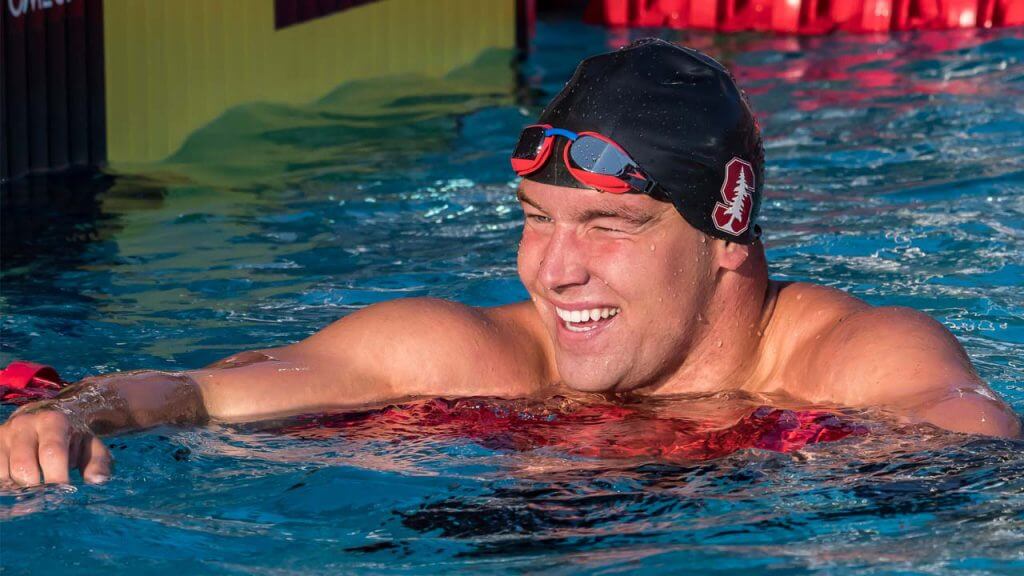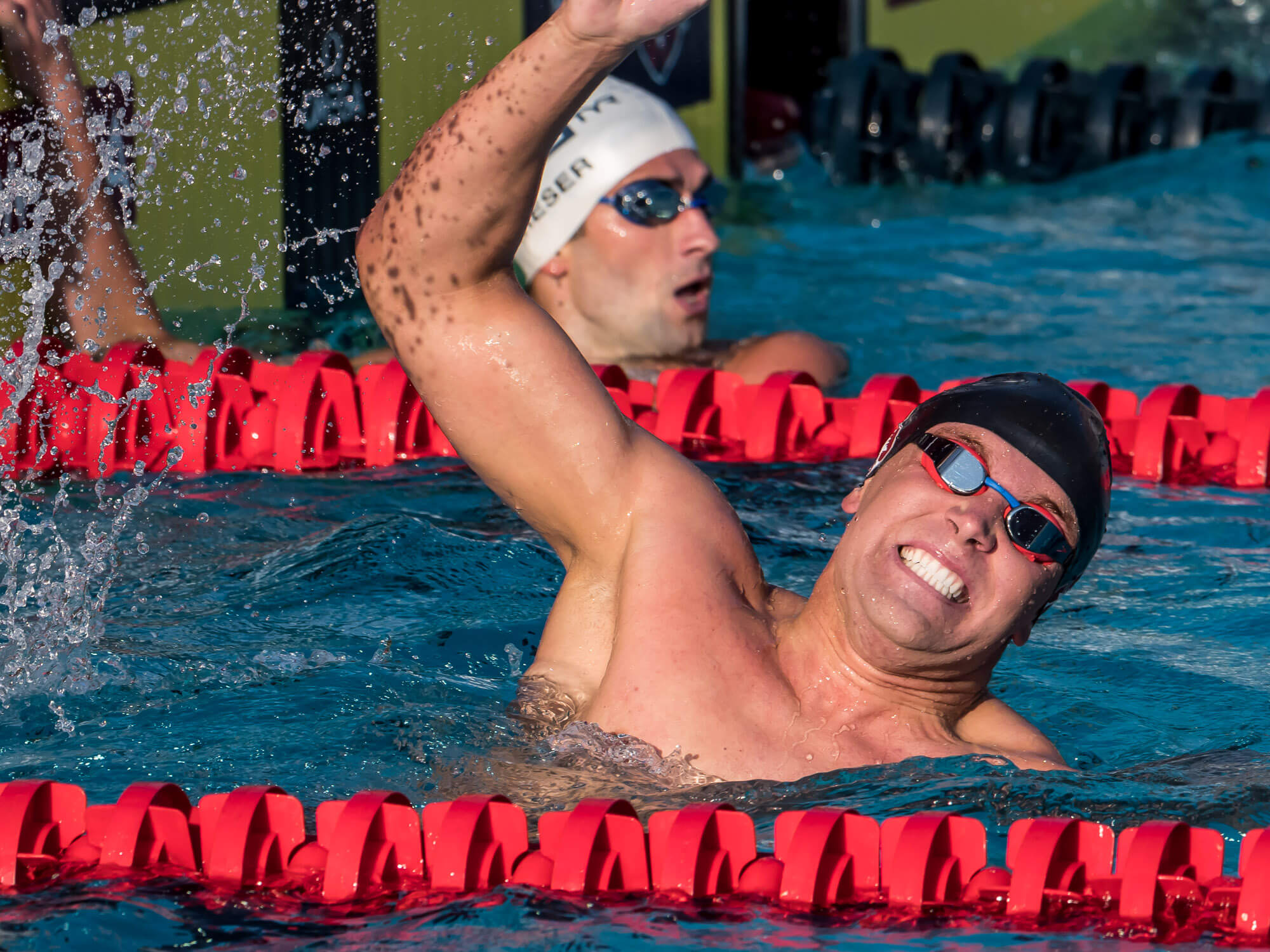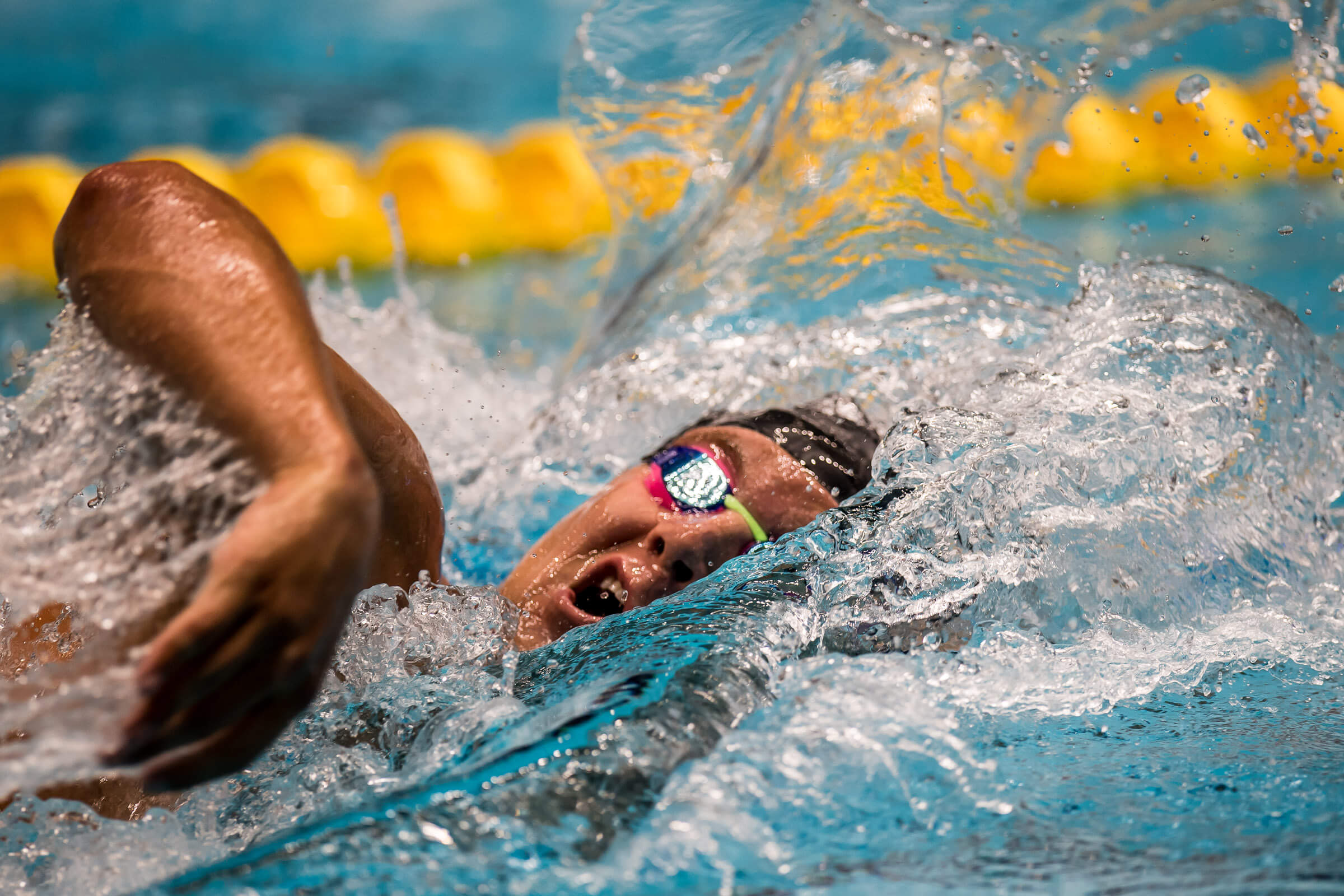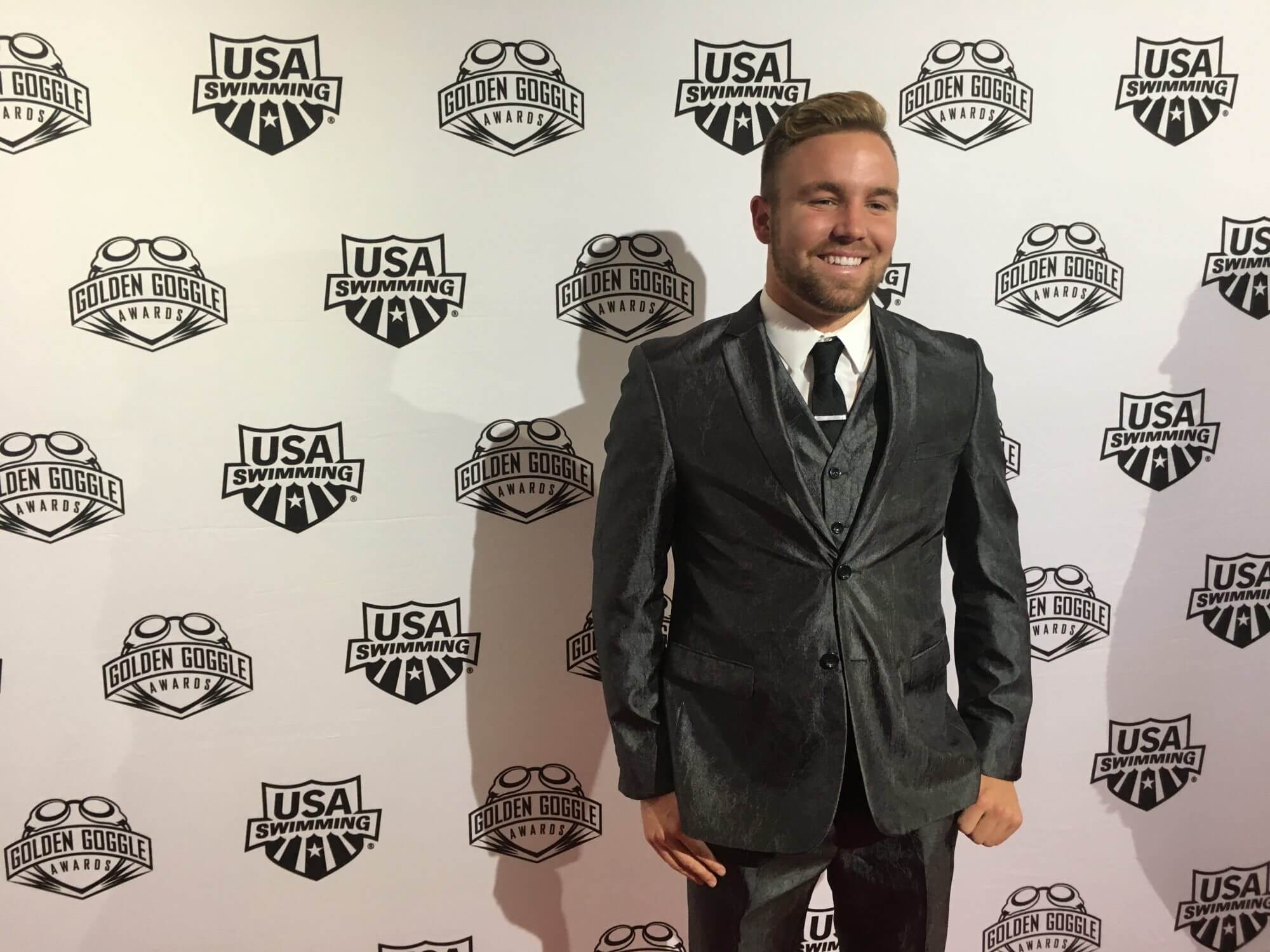After Shoulder Surgery, Grant Shoults Determined to Fight Back

Editorial content for the 2019 NCAA DI Championship coverage is sponsored by SwimOutlet.com. See full event coverage.

Grant Shoults competed in a familiar pool just miles northwest of his hometown of Laguna Hills, Calif. And he swam the race of his life, the big breakthrough he had waited for after a distinguished junior career where he won a world junior title in the 400 free and was named Swimming World High School Swimmer of the Year.
In front of a crowd filled with family and friends during the 400 free final at U.S. Nationals, he took an early lead and then settled into second place behind pre-race favorite Zane Grothe. Off the final turn, Shoults unleashed his signature underwater dolphin kicks, not quite enough to pass Grothe but plenty to secure his second-place finish. His final time of 3:46.53 was a lifetime best by more than a second.

Photo Courtesy: Peter H. Bick
This, Shoults said, was “a relief finally making a big boy team.” He added, “It’s been a long time coming for sure.” And two weeks after that, Shoults finished fourth in the 400 free at the Pan Pacific Championships, securing his spot on the 2019 World Championships team.
Shoults will always remember those feelings from that banner night in Irvine—relief, joy, pride and confidence chief among them. That night, Shoults’ swimming career enjoyed an abundance of upward momentum.
But after Pan Pacs, when Shoults returned to Stanford for his junior year of NCAA swimming, he felt pain in his shoulder. Frustration kicked in as the pain kept coming back. He raced just once more in 2018, with a total of four seemingly-disappointing races at the Texas Invitational the weekend after Thanksgiving.
And the next the world heard from Shoults was January 3, 2019, when he posted to social media a photo of himself wearing a hospital gown, having just undergone shoulder surgery. That 400 free in Irvine, just more than five months earlier, seemed so far away.
===
Shoults remembers the first day he felt pain in his right shoulder: September 15, during one of Stanford’s first Saturday practices of the season. Assigned a set of 25s that involved hopping out of the pool for push-ups, squats or dips in between, Shoults went down for a dip and tried to extend his arm. Then came the pain.
After playing baseball during his younger years, Shoults had battled an elbow injury and tendonitis in the past, but he had been injury-free for years. His shoulders had never caused him trouble. But this pain was so severe that Shoults didn’t take a stroke for three days. Then he returned to regular training for 10 days, only for the pain to flare up again.
This time, Shoults shut it down and pursued treatment. There was an MRI, iontophoresis, physical therapy, multiple cortisone shots. He stayed in shape by kicking and riding a stationary bike, but he would not pull again until mid-November.

Photo Courtesy: Peter H. Bick
By that point, Shoults had just over two weeks to ramp up to swim the 500 free and 400 IM at the Texas Invite. By his usual standards, 4:20.23 and 3:49.44 were nothing special, but given the circumstances, “I was cool with it,” Shoults said. “I thought it was not too bad for just coming back.”
He ended up scratching the 200 fly on the last day of that meet as a precaution, but after that, Shoults finally returned to regular training, fully confident he would be prepared to swim at full strength (including in the 1650 free) by the end of the season.
“I got back incorporated with the group. I had some great practices,” Shoults said. “I finally felt like I was getting away from the injury and everything was finally working out.”
Until a few days before Christmas, when Shoults had returned home to Southern California. Swimming on his own, he felt a right shoulder pain deeper than any he had before. Visits with several doctors, including the family friend that had operated on his elbow years earlier, diagnosed him with a slap tear—that is, the upper region of his labrum was torn, and that was putting pressure on his biceps tendon.
Doctors told Shoults he could attempt to further rehab the injury, but all recommended surgery.
“It was a better decision to bite the bullet because I would eventually have to have surgery on my shoulder,” Shoults said. “It hurt to drive a car. It hurt to pick up a glass. It hurt to cut vegetables. I literally couldn’t do anything with my right arm. It wasn’t just affecting swimming. It was affecting my everyday life.”
And so surgery it was. Shoults spent the first week of Stanford’s training camp with his teammates but kicking and biking only, “just to stay in shape and be with the team.” On Jan. 2, he got the call that surgery would be the next day. So he went in, and Stanford orthopedic surgeon Geoff Abrams inserted two anchors into his labrum.
===
Four days after surgery, Shoults was still taking heavy doses of pain medicine, but he was in class for the first day of winter quarter. The day after that, he moved his arm for the first time. But he can’t write, so he had to drop the math class he had signed up for. In another class, one of Shoults’ classmates had to fill out a form on his behalf.
As for his recovery, Shoults is not allowed in the pool to kick for two weeks after surgery, and he will have to wear a sling for most of January. He will resume his work on the stationary bike as soon as it’s not painful to sit in that position. For the foreseeable future, physical therapy sessions will be three times per week.

Photo Courtesy: Diana Pimer
“My physical therapists were happy with the progression that I’ve had,” Shoults said. “I had to see them one day post-surgery, and it was absolutely horrible. I needed to get stronger meds. They tried to take my arm out of the sling, just to see if I could do anything, and I just broke down because of the pain. Since then, it’s gotten a lot better.”
He expects that within two-and-a-half to three months, he will be able to move his arm, but it will be six to seven months before he can return to full-on hard swimming. That means he is definitely out for this NCAA season, but he expects to be granted a redshirt given that he only competed in one invitational all season. Still, he plans on being around his team as much as possible.
“I plan on being the team mom,” Shoults said.
The timeline means the World Championships, scheduled for late July in Gwangju, South Korea, are up in the air. Shoults would hate to give up an opportunity he worked so hard to earn, but he knows he must be smart.
He has communicated with USA Swimming National Team Managing Director Lindsay Mintenko, who told him that she needs to know by June 20 if he is in or out. If Shoults has to decline the spot, Conor Dwyer is next in line to swim the 400 free in Gwangju.
“I want to go to Worlds, obviously,” Shoults said. “It’s still up in the air. I don’t want to rush the recovery period and ramping back up into swimming because next year is more important, obviously, but I don’t want to take it too slow because I do want to compete and I do want to get back. I am listening to doctors’ orders.”
But the whole situation is hard, and Shoults admits that. Sure, it’s a bit of a silver lining that the injury happened now and not in the immediate lead-up to Olympic Trials, but that it came right after the most successful season of his career only adds to the frustration.
“It’s tough. It honestly is tough, and there’s a lot of ways you can go about thinking about this,” Shoults said. “You can feel sorry for yourself. I’m just really grateful for the season I had last year. Now it’s in the past, and I’m in a new season, and just like every season, you have to turn the page. This season is a little different, and that’s fine. I know that I’ll get back.”
Shoults has avoided feeling like his world is crashing down by reminding himself that swimming is not his whole life, and this surgery does not affect any of that—at least by February when he gets out of his sling. He still has his family, his social life at Stanford, his religious life and even his relationship and standing with his Stanford team.
And he has his confidence, his staunch belief that he will make it back to his former level in plenty of time for Olympic Trials.
“I think it’s just the kind of person that I am. I’ve always been really driven. I’ve always had a strong work ethic. I don’t like losing. Those things are pretty cohesive in terms of getting back into the regimen I was once in,” Shoults said.
“I think it just comes down to the confidence that I have in myself and the confidence I have in the people around me to help me get to that point. I think that where I am right now, I’m in the right position to make a full comeback, and I don’t see that there’s a reason why I shouldn’t be able to.”
.jpg)
- LIVE RESULTS
- LIVE STREAM (PRELIMS)
- LIVE STREAM (FINALS)
- PSYCH SHEETS
- MEN'S RELAYS
- MEN'S TEAMS
- MEN'S DIVERS
- 2018 FULL RESULTS
- 2017 FULL RESULTS
- 2016 FULL RESULTS
- ALL COLLEGE NEWS
- NCAA OFFICIAL PAGE
- LINK TO 2019 NCAA WOMEN DI CHAMPIONSHIPS
- SWIMOUTLET.COM 2019 TECH SUIT REVIEW
- PREDICTIONS (PART ONE)
- PREDICTIONS (PART TWO)
- 2019 FULL RESULTS




Me too!
Caroline Hippen. Your story.
Why would Dwyer be the replacement? Wieser was third at Nationals.
It’s whoever had a faster time with nationals and pan pacs combined